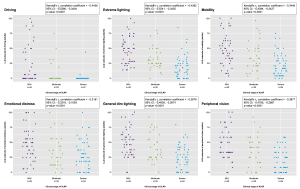Researchers at the Department of Translational Medicine, University of Ferrara, Italy, and colleagues in the ERN-EYE Network, have published paper on the first study to report data on the complex burden of XLRP linked to disease stages. Researchers stated that, “to date, no studies have specifically explored social, economic, psychological and emotional burdens in people with XLRP, leaving a significant gap in our understanding of how patients are affected by this disease, particularly during its different stages.” In their report, the “EXPLORE XLRP-2” study, supported by the ERN-EYE network, was undertaken to collect real-world data directly from patients and from their medical records across multiple countries.
X-linked retinitis pigmentosa (XLRP) is considered one of the most severe forms of RP, accounting for 5–15% of all RP cases. More than ~75% of XLRP cases are caused by mutations in the retinitis pigmentosa GTPase regulator gene (RPGR), resulting in irreversible degeneration of photoreceptors. The gene encodes a ciliary protein that regulates trafficking of proteins to the outer segment of photoreceptors. Males are more severely affected by the X-linked pathology with night blindness generally occurring within the first decade of life, followed by restriction of the visual field and loss of visual acuity leading to legal blindness in most patients by the fourth to fifth decade of life. As the disease progresses, patients experience visual field deterioration, while acuity of central vision also declines leading to legal blindness at a median age of 45 years. However, the disorder may also affect female carriers potentially experience a range of mild-to-severe progressive visual impairments.
In their recent study, EXPLORE XLRP-2 was a non-interventional study conducted in 23 centres across 10 countries (Austria, Belgium, England, Finland, France, Germany, Israel, Italy, the Netherlands and Spain). Each participating site identified male and female patients who were aged ≥12 years at screening and received a predicted disease-causing sequence variant in RPGR confirmed by genetic testing. Following their results the research team enrolled 176 patients with XLRP, of whom 169 were included in analyses. 81% of patients were male, with a mean (SD) age was 39.3 (17.61) years, and 20 adolescents were included. The mean age (SD) at genetic confirmation was 33.4 years (17.98), and the mean duration (SD) from initial symptoms to genetic diagnosis was 16.4 (15.66) years. According to the data, there researchers stated that, “compared with patients with mild disease, patients with severe XLRP are more likely to experience difficulties with functioning in low luminance, depression, unemployment, productivity issues, mobility and daily activities.”
Figure 1: Modified LLQ outcomes. A score of 0 indicates maximal difficulty, and a score of 100 indicates no difficulty. LLQ Low Luminance Questionnaire, XLRP X-linked retinitis pigmentosa. [Open access article is licensed under a Creative Commons Attribution 4.0 International License, which permits use, sharing, adaptation, distribution and reproduction in any medium or format when provided to the appropriate credit of: Parmeggiani, F, et al., The burden of X-linked retinitis pigmentosa (XLRP) on patient experience and patient-reported outcomes (PROs): findings from the EXPLORE XLRP-2 study. Eye (2025). https://doi.org/10.1038/s41433-024-03546-8].
In their conclusion, the paper showed that, “the outcomes of this study offer valuable insights into the impacts of XLRP on many aspects of daily life. Our findings highlight unmet needs of patients with XLRP, who are faced with significant emotional and societal burdens that increase as the disease progresses. Understanding these needs is critical for development of novel therapies and management strategies for XLRP. Further studies that continue to explore the patient experience of living with XLRP are needed to deepen our understanding of humanistic impacts of this disease, particularly across other regions.”

